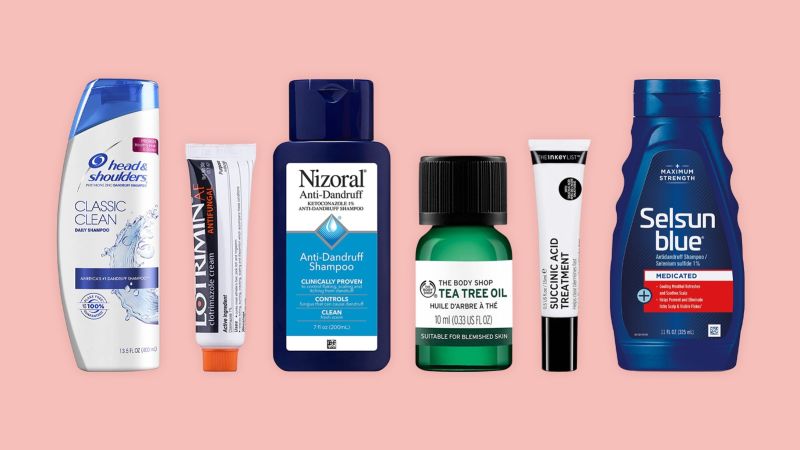
It turns out the internet was onto something when people began praising dandruff shampoo as a skin care treatment. The dermatologist-approved trick specifically targets fungal acne and can help clear up the symptoms of yeast-derived breakouts.
To find out if it’s right for you, we spoke to dermatologists about what exactly fungal acne is, how dandruff shampoo can help and what products to try.
If you’ve noticed stubborn and itchy bumps below the skin that don’t seem to go away with traditional acne products, it might be fungal acne. Caused by malassezia yeast, this is also known as pityrosporum folliculitis and it differs from acne vulgaris, or the standard type of acne we normally think of when we see blemishes.
“Fungal acne is a common misnomer as the condition isn’t really acne,” explains Dr. Ramya Garlapati, a Los Angeles-based board-certified dermatologist and co-founder of Skin Medicinals. “It’s actually a folliculitis, or an infection of the hair follicles, due to an overgrowth of yeast and therefore the condition does not respond to conventional acne treatments.”
Instead, fungal acne needs to be treated with antifungal agents that can combat the proliferation of yeast in the hair follicles.
Treatment for fungal acne can include over-the-counter skin care products and oral medication, as well as the not-so-secret life hack of using anti-dandruff shampoo. Both dermatologists we spoke to, as well as many others on social media, have confirmed its efficacy at treating the condition.
“Using dandruff shampoos as a face or body cleanser to treat fungal-related skin conditions such as fungal acne or seborrheic dermatitis is actually something I recommend to my patients,” says Garlapati. But before trying the viral trend, Garlapati reminds us that it’s still “important to first have your skin concern assessed by a dermatologist to ensure it’s a fungal-related condition.”
Benefits of dandruff shampoo for fungal acne
Dandruff is caused by the same malassezia yeast that is at the root of fungal acne, so anti-dandruff products and scalp care treatments can also be used to target the skin condition.
“Anti-dandruff shampoos that contain active ingredients that have antifungal properties such as zinc pyrithione, selenium sulfide and ketoconazole are most effective at treating fungal acne,” Garlapati says. “You don’t need to search for a skin care product that contains these ingredients, as an anti-dandruff shampoo can also be utilized as a face or body cleanser.”
And while there are over-the-counter and prescription-strength options, the dandruff shampoo that you’ll find in the hair care aisle of your drugstore will do the trick. Board-certified dermatologist Dr. Jenny Liu says that common name brands, such as Nizoral (containing ketoconazole) and Head and Shoulders (containing pyrithione zinc) are safe to use on your face.
Side effects of using dandruff shampoo on skin
As with any skin or hair care product, there is a risk of irritation, so always patch test on a small spot away from your face, like your arm, before using dandruff shampoo as a face wash. Nizoral also lists rash as a possible side effect, and you should stop use if one appears in the treated area.
Moreover, Liu notes that dandruff shampoos “can be drying, so I recommend limiting use to a few times weekly.”
How to use dandruff shampoo for fungal acne
Once you’ve grabbed your anti-dandruff shampoo of choice, you can use it as a face wash or mask to treat fungal acne. “The key when using the product is to lather it up and allow it to sit on the skin for a few minutes before rinsing it off,” Garlapati says. “The shampoo should not be immediately washed off as the product needs to be in contact with the skin for a few minutes for the treatment to be effective.” Liu recommends doing this in the shower as it’s easiest to incorporate into your routine.
Both Garlapati and Liu recommend using Nizoral on the face and body to treat fungal acne. It contains ketoconazole, an ingredient that fights the fungus that causes dandruff and pityrosporum folliculitis.
Good ol’ Head and Shoulders contains fungus-fighting pyrithione zinc to combat the malassezia yeast that causes the bumpy, clogged follicles of fungal acne.
Recommended by Garlapati, Selsun Blue uses the antifungal agent selenium sulfide to balance the scalp and skin. The formula contains menthol, which causes a cooling effect, so those with sensitive skin may want to be cautious.
Those who look to natural remedies may want to try tea tree oil. “Tea tree oil is known for its antimicrobial properties and is effective at treating fungal conditions,” Garlapati says. “Keep in mind some individuals with sensitive skin can have a reaction to tea tree oil, so it’s best to patch test the product before applying it all over the affected area.”
Liu says salicylic-acid-based treatments can help mild cases of fungal acne. She likes this gentle option that contains salicylic acid along with succinic acid and sulfur powder, two antimicrobial ingredients that will help tackle traditional breakouts as well as fungal acne bumps.
Whether you’re experiencing pityrosporum folliculitis or athlete’s foot, the cause of the uncomfortable conditions is the same: fungus. Garlapati says that an athlete’s foot cream can also be a helpful treatment for fungal acne since it contains clotrimazole, an effective antifungal ingredient.

